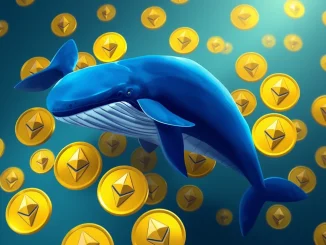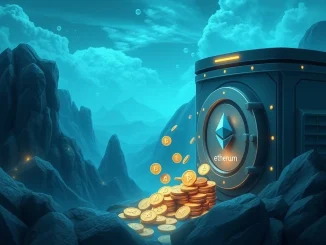
In the often-opaque world of cryptocurrency, large movements of digital assets by major holders, known as ‘whales’, frequently capture attention. Recently, a significant transaction involving Solana (SOL) caught the eye of market observers, particularly those tracking onchain data. A prominent crypto whale has moved a substantial amount of SOL, signaling potential strategic intent within the Solana ecosystem.
Solana Whale Makes a Big Splash
Approximately two hours ago, a notable event unfolded on the Solana blockchain. An anonymous wallet address, identified as a whale due to the size of its holdings and transactions, withdrew a staggering 54,000 SOL tokens. At the time of the transaction, this amount was valued at roughly $9.46 million.
The withdrawal originated from the Kraken Exchange, a popular platform for trading various cryptocurrencies. Such a large movement off an exchange often indicates that the holder intends to do something other than immediate trading, such as securing assets in cold storage or, as in this case, engaging in network participation activities like staking.
Why the Kraken Withdrawal Matters
Moving assets off a centralized exchange like Kraken is a deliberate action. For a large holder like a Solana whale, it typically signifies a longer-term perspective on the asset. Holding tokens on an exchange is convenient for trading but exposes the user to potential risks associated with the platform itself. By withdrawing, the whale takes direct control of their assets.
The destination of these funds is particularly insightful. The 54,000 SOL were reportedly transferred specifically for staking purposes. This move suggests confidence in the Solana network’s stability and future prospects, as staking involves locking up assets to support network operations and earn rewards.
Understanding SOL Staking
SOL staking is a core mechanism of the Solana network, which operates using a Proof-of-Stake (PoS) consensus mechanism combined with its unique Proof-of-History (PoH). Staking allows SOL holders to participate in validating transactions and securing the network. In return, stakers can earn passive income in the form of newly minted SOL tokens or transaction fees.
Here are some key aspects of staking SOL:
- How it Works: Users delegate their SOL to a validator node. Validators run the software that processes transactions and maintains the blockchain.
- Rewards: Stakers earn a portion of the rewards generated by the validator they delegate to. The annual percentage yield (APY) for SOL staking can vary based on network conditions, inflation, and validator commission fees.
- Lock-up Periods: Unlike some other PoS networks, Solana staking involves ‘epochs’ (periods of time, typically 2-3 days). While not a fixed long-term lock-up, unstaking requires waiting until the end of the current epoch, during which the tokens are inactive and not earning rewards.
- Risks: The primary risk is ‘slashing’, where a validator is penalized (and a portion of delegated SOL is lost) for malicious behavior or poor performance. Choosing a reliable validator is crucial. Price volatility of SOL is also a risk; the value of staked assets can decrease.
For a crypto whale with millions of dollars in SOL, staking represents a way to generate yield on a significant holding without needing to actively trade, while also contributing to the network’s health and security.
Insights from Onchain Data
The information about this transaction comes courtesy of platforms specializing in onchain data analysis, such as Onchain Lens on X (formerly Twitter). These tools provide transparency into blockchain activity, allowing anyone to track the movement of assets between wallets, exchanges, and protocols.
Tracking whale movements using onchain data can sometimes offer insights into market sentiment or potential upcoming trends, although it’s important not to interpret single transactions in isolation. This specific move, for instance, provides concrete evidence of a large holder committing capital to long-term participation via SOL staking rather than holding on an exchange for potential short-term trading.
What This Crypto Whale Move Could Mean
The decision by this crypto whale to move $9.46 million in SOL for staking can be interpreted in several ways:
- Confidence in Solana: Staking is a long-term commitment. This move suggests the whale believes in the future growth and stability of the Solana network.
- Seeking Passive Income: With a large amount of capital, even a modest staking APY can generate substantial returns over time, providing a passive income stream.
- Reducing Exchange Risk: By moving assets off Kraken, the whale mitigates potential risks associated with holding funds on a centralized platform.
- Contributing to Network Security: Large amounts of staked SOL increase the network’s security and decentralization by adding more weight behind honest validation.
While this single Kraken withdrawal for staking doesn’t guarantee future price movements, it is a positive signal from a major market participant regarding their long-term view on Solana and their commitment to supporting the network through SOL staking.
Summary
A significant crypto whale has withdrawn 54,000 SOL, valued at $9.46 million, from the Kraken Exchange and allocated it towards SOL staking. This move, highlighted by onchain data analysis, signifies a long-term commitment to the Solana network and a strategy to earn passive income while contributing to network security. The large-scale Kraken withdrawal for staking underscores confidence from major holders in Solana’s future, offering an interesting data point for those following the SOL ecosystem.



